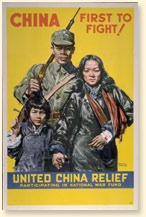

China First to Fight! |
War in China, 1937-1945
Japan was a powerful nation but also an island nation, without
enough food or resources to survive on its own. The most
obvious place to exploit was nearby China, weak and chaotic. In 1931
the Japanese army seized control of the Chinese province of
Manchuria, turning it into a puppet of Tokyo. In 1937 the Japanese
army took charge of much of eastern China - the most fertile,
heavily populated parts of the country. By the following year, both
the old capital of Beijing and the new capital of Nanking had fallen
to the Japanese.
Within China Chiang Kai-shek's Nationalist government ( Kuomintang )
was fighting off Mao Zedong's rebel Communists. Faced with the
threat from Japan, however, the two enemies decided to stop their
war to combat the outsider. They waged all but separate wars against
the Japanese. The Communists, based in the distant, rural northwest,
had considerable support in the countryside and villages, even from
areas behind the Japanese lines, but had only the most basic
equipment for an army. The Nationalists, in equally remote Szechuan
in the west, had a huge army, which was less motivated and less
well-led and had only a little more equipment than the Communists.
Until 1941 the Nationalists received some equipment from the Soviet
Union. The Americans sent some troops, pilots and supplies to the
Nationalists from India over the rugged Burma Road until it was cut
by the advancing Japanese army in Burma ( see the Burma Campaign, 1941-1945 ). Until a land route was re-opened in 1945, any Allied
military aid to China had to be flown over the Himalaya mountains
from India.
China was a Second World War backwater. However, the largest part of
the Japanese army was tied down in China, maintaining internal
order, and this limited what Japan could do in its war
against the .
Related Newspaper Articles
English Articles
- Japanese Airmen Kill Toronto Chinese Flier
The Globe and Mail, 03/12/1937
- Local Chinese Deeply Worried by Deadly Peril
The Hamilton Spectator, 08/01/1938
- Man Who Saved Many Lives Has Died in Service
The Hamilton Spectator, 27/11/1939
- A Significant Anniversary
The Toronto Daily Star, 18/09/1941
- Greater East Asia - Testing-Ground of Japan's Expansion
The New York Times, 13/12/1942
- Use Aeroplanes if Burma Road Falls to Enemy
The Hamilton Spectator, 17/02/1942
- Chinese Protest Idea of Cleaning Up Europe First
The Hamilton Spectator, 05/01/1943
- Front Line Troops Receive U.S. Arms and Ammunition
The Hamilton Spectator, 28/02/1944
- Canadian-Chinese Flier Fools Japs to Aid Kin
The Globe and Mail, 02/05/1944
- China Communists Train Big Militia
The New York Times, 15/10/1944
- 'Hump' air route to china closed
The Globe and Mail, 03/01/1946
French Articles
-
Le conflit sino-japonais
Le Devoir, 26/04/1940
-
Les infirmières missionnaires en Chine
Le Devoir, 05/05/1941
-
La plus grande offensive chinoise
Le Devoir, 09/10/1941
-
Collaboration entre l'Inde et la Chine
Le Devoir, 10/02/1942
-
Chine et Canada. Le nouveau ministre présente ses lettres de créance à Ottawa
Le Devoir, 28/02/1942
-
"En se battant pour sa liberté, la Chine se bat pour la nôtre"
Le Devoir, 12/05/1942
-
Chine. La situation reste très grave
Le Devoir, 26/05/1942
-
Chine. Offensive japanaise dans Kouangtoung
Le Devoir, 01/06/1942
-
Chine. Cinq années de guerre
Le Devoir, 07/07/1942
-
La Chine dans la guerre
Le Devoir, 18/06/1943
-
Américains et Chinois
Le Devoir, 14/10/1943
-
Point de vue chinois. Sept années d'une terrible guerre
Le Devoir, 06/07/1944
-
Tchiang Kai-chek et la guerre civile
Le Devoir, 10/08/1944
-
La situation critique de la Chine et la guerre contre le Japon
Le Devoir, 14/09/1944
-
L'affaire Stilwell
Le Devoir, 02/11/1944
-
La situation militaire en Chine
Le Devoir, 07/12/1944
-
Les soldats américains en Chine
Le Devoir, 25/04/1945
-
L'armée chinoise recapture le port de Nan-Ning
Le Devoir, 28/05/1945
-
La Chine s'achemine vers la démocratie
Le Devoir, 13/06/1945
-
Le relèvement de la Chine
Le Devoir, 13/06/1945
|